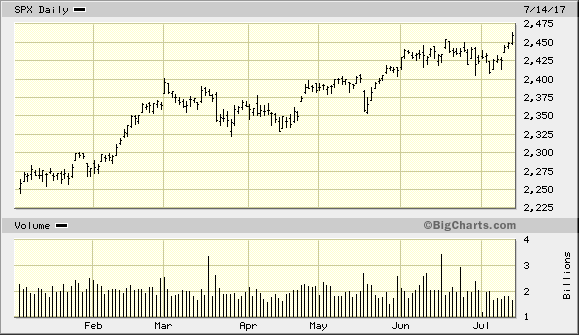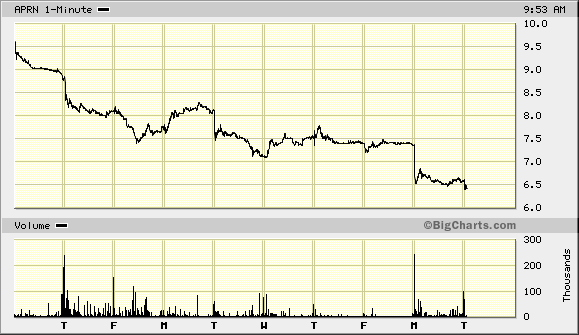-
Smucker Raises Dividend by 4%
Posted by Eddy Elfenbein on July 19th, 2017 at 7:34 pmGood news for Smucker (SJM). The jelly people raised their dividend by 4%, from 75 to 78 cents per share. This is their sixteenth annual dividend increase. The new dividend will be paid on Friday, September 1 to shareholders of record at the close of business on Friday, August 11.
-
Signature Bank Earns $2.21 per Share
Posted by Eddy Elfenbein on July 19th, 2017 at 1:47 pmThis morning, Signature Bank (SBNY) kicked off the second-quarter earnings season for our Buy List stocks. The bank reported quarterly earnings of $2.21 per share which matched Wall Street’s consensus.
But there’s a big caveat to that number. It doesn’t include Signature’s “provision expense and write-downs for the taxi medallion portfolio.” As we’ve known, SBNY took at bath on those medallion loans. Uber and others have knocked that entire industry. But as I’ve said, this is a known problem and SBNY has been working on it.
“We did not, nor did any others, foresee the dramatic decline in taxi medallion values caused by a combination of rapid radical disruption by app-based hailing systems and inaction by governmental authorities. We did, however, see the disruption coming in time to set an upper limit on loan amounts and to stop our lending earlier than most,” said Scott A. Shay, Chairman of the Board.
Net interest margin, the key metric for any bank, was 3.11% during Q2. That’s pretty good. Overall, this was an OK quarter for Signature. It’s largely what I expected. The shares dropped sharply at the open, but recovered some ground. SBNY is currently down about 1.5%.
-
Morning News: July 19, 2017
Posted by Eddy Elfenbein on July 19th, 2017 at 7:07 amHow Trump Could Puncture the Equity Bubble
Net Neutrality Or Continued Innovation? Can’t We Have Both?
Mustard at a Price That Makes Your Eyes Water
Frontier Airlines is Doubling in Size
Discovery, Viacom Said to Have Held Talks to Acquire Scripps
Volvo Profit Jumps on 22% Rise in Truck Orders
Shareholders Weigh British American, Reynolds Tobacco Merger
Harley-Davidson Spirals Down, Announces U.S. Layoffs, Builds Factory In Thailand
Daimler Will Recall 3 Million Diesel Cars Across Europe to Fix Emissions
Investors Spooked By Sick Chipotle Customers
AMC Tries to Steer Clear of Chinese Owner’s Debt Worries
Ben Carlson: What’s Your Track Record?
Cullen Roche: Are ETFs and Index Funds More Dangerous in a Bear Market?
Roger Nusbaum: Is a Minsky-esque Moment Coming?
Be sure to follow me on Twitter.
-
How Broker Rebates Work
Posted by Eddy Elfenbein on July 18th, 2017 at 11:40 amIn today’s NYT, Jonathan Macey and David Swensen write on the pernicious practice of broker rebates. Brokers are supposed to get the best trades for their clients:
But that’s not what is happening. Instead, brokers routinely take kickbacks, euphemistically referred to as “rebates,” for routing orders to a particular exchange. As a result, the brokers produce worse outcomes for their institutional investor clients — and therefore, for individual pension beneficiaries, mutual fund investors and insurance policy holders — and ill-gotten gains for the brokers.
Although the harm suffered on each trade is minuscule — fractions of a cent per share — the aggregate kickbacks amount to billions of dollars a year. The diffuse harm to individuals and the concentrated benefit to Wall Street create yet another way in which the system is rigged, justifiably eroding public confidence in the fairness of the financial system.
-
Blue Apron Blues
Posted by Eddy Elfenbein on July 18th, 2017 at 9:55 amThe Blue Apron IPO has been a disaster. The pricing had to be chopped ahead of the IPO, and the shares have dropped even lower since then.
APRN got to $6.36 per share this morning, a new low. The IPO priced at $10 per share.
-
Reply to Barron’s
Posted by Eddy Elfenbein on July 18th, 2017 at 8:25 amThis weekend, Barron’s profiled my actively managed ETF. I felt the profile was unusually hostile and that it missed several key points about our ETF.
You can read my response here.
-
Morning News: July 18, 2017
Posted by Eddy Elfenbein on July 18th, 2017 at 6:58 amU.K. Inflation Rate’s Unexpected Drop Takes Pressure Off BOE
Trump Failure on Healthcare Sends Dollar to 10-Month Low
Microsoft, Google Back Strong Net Neutrality Rules
2 Safe High-Yield REITs With Excellent Growth Prospects Trading At Fire Sale Prices
Netflix Shares Set to Skyrocket to Highest Price Ever
Novartis Tops Q2 Earnings Estimate, Boosts Alcon Full Year Sales Guidance
Why Nelson Peltz Wants P&G to See Him as a `Constructivist’
Hampton Creek’s Entire Board Leaves Except for CEO
Disney Looking to Alleviate ESPN Woes in Altice Contract Talks
Ericsson Plans More Cost Cuts as Shares Plunge After Poor Q2
Wells Fargo Poised to Sell More Businesses As It Streamlines Following Accounts Scandal
Jeff Carter: Blockchain Will Disrupt Everything
Michael Batnick: These Are The Goods
Howard Lindzon: Momentum Monday and Billionaires Bitching
Be sure to follow me on Twitter.
-
My Delta Tweet Goes Viral
Posted by Eddy Elfenbein on July 17th, 2017 at 2:17 pmThis morning, I posted what I thought was a light-hearted tweet about Delta’s stock after this weekend’s Ann Coulter incident.
Shares of Delta are down 26 cents (about $190 million in market value) post Coulter. As always, correlation/causation… $DAL
— Eddy Elfenbein (@EddyElfenbein) July 17, 2017
I truly meant nothing by this, and I think my long-time readers understand that. Little did I realize that the tweet would be RT’d by Ms. Coulter herself.
For most of the day, my Twitter timeline has been flooded by people calling me a total moron, and trying to explain to me how this stock market thingy works.
I’ve also been told that I’m wrong — correlation does not in fact mean causation. (I thought that’s what I said!)
Ah…Twitter.
But I’m curious about something: why do so many people who clearly hate Ann Coulter bother following her on Twitter? Wait…I think I know the answer.
-
Morning News: July 17, 2017
Posted by Eddy Elfenbein on July 17th, 2017 at 7:07 amOil Skeptics Let a Little Sunshine In
ECB Eyes Review of Deutsche Bank Shareholders
China’s Strong Second Quarter GDP Growth Paves Way For Deeper Reforms
Emirates Signs Partnership Deal With Discount Neighbor FlyDubai
Firms Under Pressure as Labor Drought Grows, U.S. Survey Shows
Major Tech Firms Urge U.S. to Retain Net Neutrality Rules
Going Cashless? Bad for Tax Cheats, Privacy, Poor
In Urban China, Cash Is Rapidly Becoming Obsolete
After Wanda Deal, Chinese Property Developer Faces Debt Risk
BlackRock second-quarter profit rises 8.6%
Google’s AI Genius Said There Could Be An ‘Epochal Event’ That Makes Robots Way More Productive
What Milton Friedman Got Right, and Wrong, 50 Years Ago
Ben Carlson: The Ups & Downs of Leveraged ETFs
Cullen Roche: Three Things I Think I Think – The Bubble Cometh?
Joshua Brown: Chart o’ the Day: Emerging Stocks Break Decade-Long Downtrend!
Be sure to follow me on Twitter.
-
ATH
Posted by Eddy Elfenbein on July 15th, 2017 at 4:00 pmThe stock market closed at yet another all-time high. The S&P 500 finished Friday’s trading at 2,459.27.

-
-
Archives
- March 2025
- February 2025
- January 2025
- December 2024
- November 2024
- October 2024
- September 2024
- August 2024
- July 2024
- June 2024
- May 2024
- April 2024
- March 2024
- February 2024
- January 2024
- December 2023
- November 2023
- October 2023
- September 2023
- August 2023
- July 2023
- June 2023
- May 2023
- April 2023
- March 2023
- February 2023
- January 2023
- December 2022
- November 2022
- October 2022
- September 2022
- August 2022
- July 2022
- June 2022
- May 2022
- April 2022
- March 2022
- February 2022
- January 2022
- December 2021
- November 2021
- October 2021
- September 2021
- August 2021
- July 2021
- June 2021
- May 2021
- April 2021
- March 2021
- February 2021
- January 2021
- December 2020
- November 2020
- October 2020
- September 2020
- August 2020
- July 2020
- June 2020
- May 2020
- April 2020
- March 2020
- February 2020
- January 2020
- December 2019
- November 2019
- October 2019
- September 2019
- August 2019
- July 2019
- June 2019
- May 2019
- April 2019
- March 2019
- February 2019
- January 2019
- December 2018
- November 2018
- October 2018
- September 2018
- August 2018
- July 2018
- June 2018
- May 2018
- April 2018
- March 2018
- February 2018
- January 2018
- December 2017
- November 2017
- October 2017
- September 2017
- August 2017
- July 2017
- June 2017
- May 2017
- April 2017
- March 2017
- February 2017
- January 2017
- December 2016
- November 2016
- October 2016
- September 2016
- August 2016
- July 2016
- June 2016
- May 2016
- April 2016
- March 2016
- February 2016
- January 2016
- December 2015
- November 2015
- October 2015
- September 2015
- August 2015
- July 2015
- June 2015
- May 2015
- April 2015
- March 2015
- February 2015
- January 2015
- December 2014
- November 2014
- October 2014
- September 2014
- August 2014
- July 2014
- June 2014
- May 2014
- April 2014
- March 2014
- February 2014
- January 2014
- December 2013
- November 2013
- October 2013
- September 2013
- August 2013
- July 2013
- June 2013
- May 2013
- April 2013
- March 2013
- February 2013
- January 2013
- December 2012
- November 2012
- October 2012
- September 2012
- August 2012
- July 2012
- June 2012
- May 2012
- April 2012
- March 2012
- February 2012
- January 2012
- December 2011
- November 2011
- October 2011
- September 2011
- August 2011
- July 2011
- June 2011
- May 2011
- April 2011
- March 2011
- February 2011
- January 2011
- December 2010
- November 2010
- October 2010
- September 2010
- August 2010
- July 2010
- June 2010
- May 2010
- April 2010
- March 2010
- February 2010
- January 2010
- December 2009
- November 2009
- October 2009
- September 2009
- August 2009
- July 2009
- June 2009
- May 2009
- April 2009
- March 2009
- February 2009
- January 2009
- December 2008
- November 2008
- October 2008
- September 2008
- August 2008
- July 2008
- June 2008
- May 2008
- April 2008
- March 2008
- February 2008
- January 2008
- December 2007
- November 2007
- October 2007
- September 2007
- August 2007
- July 2007
- June 2007
- May 2007
- April 2007
- March 2007
- February 2007
- January 2007
- December 2006
- November 2006
- October 2006
- September 2006
- August 2006
- July 2006
- June 2006
- May 2006
- April 2006
- March 2006
- February 2006
- January 2006
- December 2005
- November 2005
- October 2005
- September 2005
- August 2005
- July 2005

 Eddy Elfenbein is a Washington, DC-based speaker, portfolio manager and editor of the blog Crossing Wall Street. His
Eddy Elfenbein is a Washington, DC-based speaker, portfolio manager and editor of the blog Crossing Wall Street. His